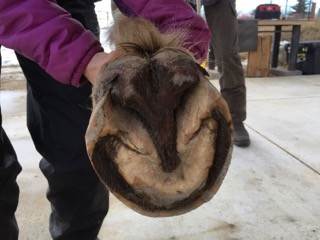Each feature of the horse hoof plays an important role in the overall health of the horse. As barefoot advocates, we emphasize on natural expansion and contraction, frog integration with the ground, and blood circulation. A good, reliable trim is what allows all of this to occur, permitting that the horse is healthy. We appreciate a well-trimmed hoof with a tight white line, complimenting angles, and a robust frog. A feature that I had long overlooked before my time at EasyCare was the bars of the hoof. An untrained eye may dismiss this facet, but when not properly cared for, the bars can contribute to heel pain, hoof wall flaring, and contribute to changes in the shape of the hoof.

The bars are a continuance of the hoof wall. They increase the surface area of the heel and assist in shock absorption during a heel first landing. The bars are both pliable and resistant enough to promote the right amount of expansion and contraction during movement. They could be described as a support to the weight bearing structures of the hoof, but the bars are not a true weight bearing structure on their own. As the hoof lands heel first, the bars help to spread the pressure amongst the digital cushion and lateral cartilages.
Too high of bars can contribute to heel discomfort with symptoms similar to navicular syndrome, leading to contracted heels. Too low of bars reduces the impact dissipation properties of the hoof and does not allow the lateral cartilages and digital cushion to function thoroughly. The bars can wear down on their own in some environments or they may need to be trimmed every 4 to 6 weeks to keep them at an adequate height. Some bars may appear to be overwhelming the sole of the hoof. This can be indicative of a thin sole and is the horse’s natural way of creating an extra layer for protection. Hoof care practitioners have their particular ways of addressing this. Other times, when the bars have gone without a trim for too long, the weight of the horse pressures the bars to fold. This, over time, can contribute to flaring. The photos below are from an Easyboot user who has taken matters into her own hands to get her horse’s hoof conformation idealized.


You can visualize that the bars have folded over. A horse with hoof conformation like this may experience heel pain because the bars are only intended to touch down during movement at a heel first landing. Heel pain can, and usually will, result in contraction of the frog. Flaring is not uncommon with the folding of the bars as the pressure from the bars often manipulates the rest of the hoof wall.



This Easybooter’s eagerness and determination to get her horse’s hooves in good condition was inspiring. I wanted to learn more about the parts of the hoof that I am not so fluent with. We set her up with a couple of pairs of Old Mac’s G2 for extra comfort and support throughout the many changes he will undergo. Using 12mm Comfort Pads, and leaving the mind open to creativity, we think we will be able to get this horse transitioned back to good with only two pairs of boots.

For more information, check out Christoph’s blog, What About The Bars? and discuss with your hoof care practitioner.
Mariah Reeves

Customer Service
As one of the customer service representatives, I am happy to help get your horse into the right boots. I promote holistic methods of equine care and will assist you with finding the perfect fit for horse and rider.





